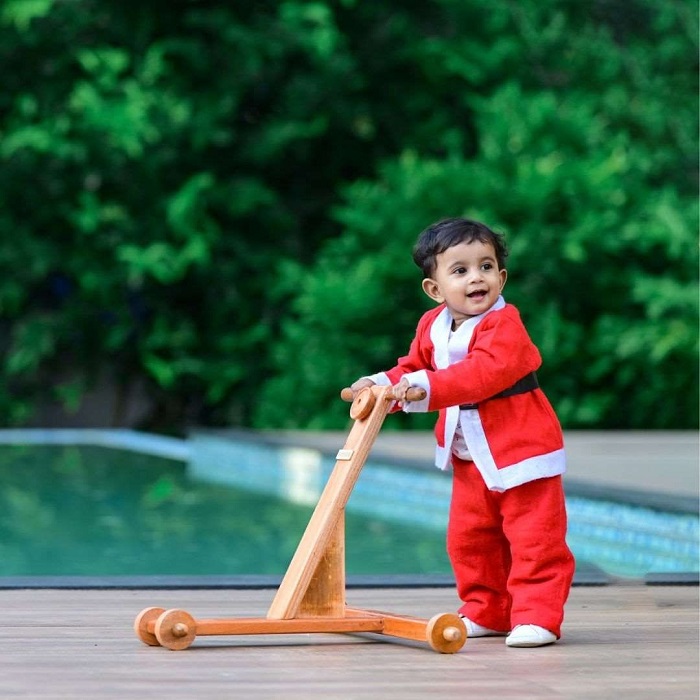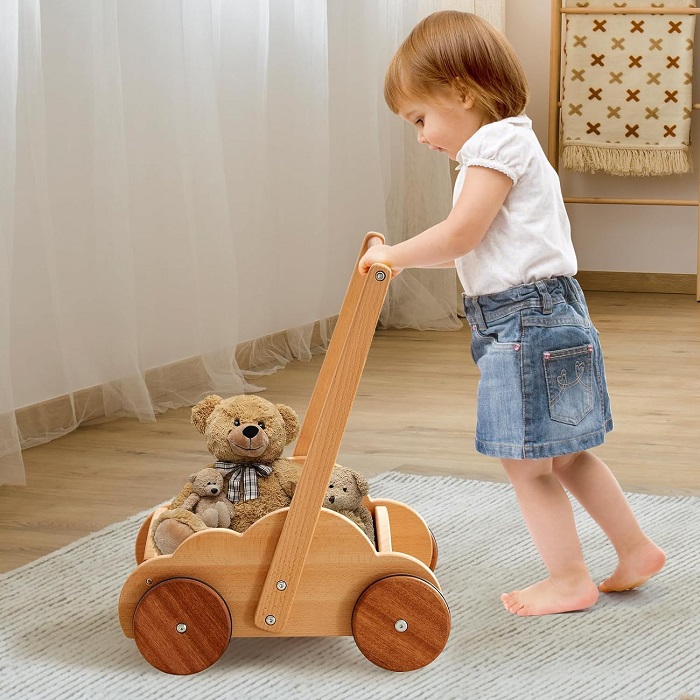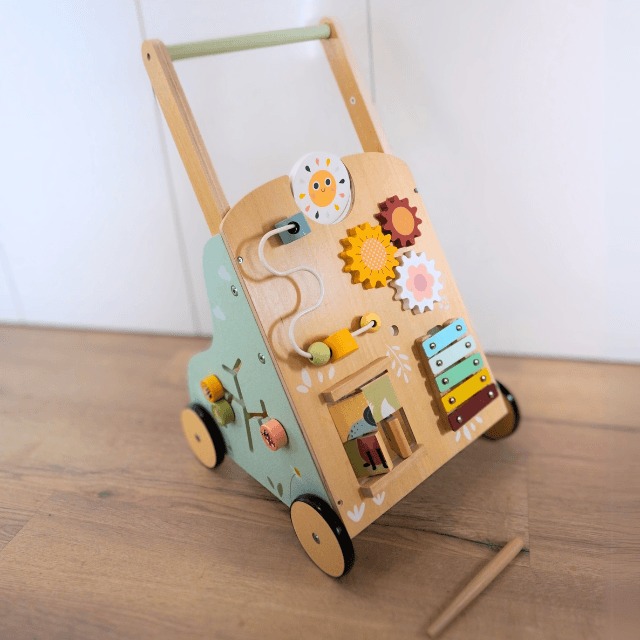The Benefits of Wooden Baby Walkers
Wooden baby walkers offer numerous advantages for infants learning to walk. While modern plastic versions are common, wooden baby walkers provide a classic touch with several benefits. Here are the key advantages to consider:
- Durability: Wooden baby walkers stand the test of time. They are sturdy and less likely to break compared to plastic models. This makes them a long-lasting choice.
- Safety: These walkers tend to be heavier, offering more stability. This reduces the risk of tipping over and ensures a safer walking experience for your baby. Safety should be prioritized, and wooden baby walkers often come with special features like non-slip wheels and smooth edges.
- Design: With their sleek and simple designs, wooden baby walkers are not just functional, but also aesthetically pleasing. They can fit into any home decor seamlessly and often become a cherished heirloom.
- Eco-Friendliness: Wooden baby walkers are eco-friendlier than plastic alternatives. They are made from natural materials and are often crafted from sustainable sources.
- Developmental Benefits: Encouraging natural walking movements, wooden baby walkers support physical development. They require a baby to push, which can strengthen leg muscles.
In short, opting for a wooden baby walker means investing in durability, safety, and sustainability. When chosen correctly, these walkers not only assist with your baby’s first steps but also offer an attractive, eco-sound toy for your little one.
Essential Safety Features in a Wooden Baby Walker
When seeking a wooden baby walker, safety is paramount. Here’s what to look for to ensure your child’s safety:
- Non-Slip Wheels: Avoid slips and slides with wheels that grip well on various surfaces.
- Sturdy Frame: A strong and durable frame prevents collapsing and withstands robust use.
- Safe Materials: Non-toxic, lead-free paint and finishes are essential for your baby’s health.
- Adjustable Speed: Some walkers offer adjustable speed settings to match your baby’s development.
- Brakes: Brakes can help control movement and prevent the walker from rolling away.
- Wide Base: A walker with a wide base can be more stable and less likely to tip over.
- Safety Certifications: Look for products that have passed safety standards and have certifications.
- Smooth Edges: Ensure all edges are smooth and rounded to prevent scrapes and pokes.
- Limited Height Adjustability: This feature helps to keep the walker at a safe height as your baby grows.
Incorporating these safety features in a wooden baby walker helps create a secure environment for your child to take those important first steps.
Age-Appropriate Use of Baby Walkers

When choosing a wooden baby walker, it’s crucial to consider your child’s age. The appropriate age for a baby to start using a walker varies, but generally, wooden walkers are best for babies who can already sit up with little to no assistance. This usually happens around six months. However, it is important to tailor this guidance to your baby’s individual development.
Here are key age-related tips for using a wooden baby walker:
- Start when ready: Begin when your baby can sit up or hold their head steady.
- Supervision is a must: Always watch your baby while they use the walker.
- Short sessions: Limit time in the walker to avoid overdependence.
- Floor-only use: Use the walker on a flat, even surface to prevent accidents.
- Physical cues: Look for signs that your baby is physically comfortable using the walker.
- Safety first: Stop using the walker if your baby becomes too active and tries to climb out.
Following these guidelines will help ensure that your baby enjoys a safe and beneficial experience with their wooden baby walker. Always remember, your baby’s safety and comfort should guide your use of any baby walker.
Top Considerations When Buying a Wooden Baby Walker
When you’re in the market for a wooden baby walker, it’s important to balance safety features with other key factors. Keep these points in mind to make the best choice for your child:
- Quality Wood: Opt for walkers made from high-quality, durable wood. This ensures a long-lasting product.
- Adjustability: Choose a walker that grows with your child, with adjustable height options.
- Design and Functionality: Simple designs with fewer gadgets are often better. They encourage natural learning and less distraction.
- Comfort: Make sure the walker has a comfortable handle for your baby’s little hands.
- Wheel Type: Select the right type of wheels for your home’s flooring to ensure good traction.
- Easy to Maneuver: The walker should be easy for your baby to push without it veering off course.
- Weight: A heavier walker offers stability but should not be too heavy for your baby to use.
By keeping these considerations in front, you can select a wooden baby walker that’s safe, reliable, and perfect for your little one’s first steps.
The Best Wooden Baby Walker Brands

When selecting a wooden baby walker, knowing which brands to trust is crucial. The right brand combines safety, quality, and design excellence. Here are top brands known for their wooden baby walkers:
- Hape: Renowned for their eco-friendly and creative toys, Hape offers walkers that stimulate and support toddlers’ development.
- Melissa & Doug: This brand is well-regarded for high-quality wooden toys. Their walkers are durable, with engaging activities.
- PlanToys: Focused on sustainability, PlanToys walkers are made with non-toxic materials and innovative designs.
- Janod: Janod’s colorful and classic-style walkers encourage discovery and motor skills advancement.
- Tidlo: Tidlo provides walkers with sturdy construction. They focus on safety and playful learning.
These brands exemplify commitment to producing wooden baby walkers that tick all the right boxes for parents. They blend in safety with functional design, ensuring that you get a product that serves its purpose well while being an attractive piece in your home.
When browsing these brands, consider their reputation in the market. Also, check for customer reviews, safety certifications, and awards that may offer insight into their reliability. Opting for a walker from a reputable brand often means a better and safer experience for your child and peace of mind for you.
Sustainability and Eco-Friendliness of Wooden Walkers
Choosing a wooden baby walker isn’t just about functionality and safety; it’s also about making an eco-conscious decision. The sustainability and eco-friendliness of wooden walkers are vital factors for many parents. Let’s explore why they are considered a greener choice.
- Natural Materials: Wooden walkers are crafted from natural wood, which is a renewable resource. This is less taxing on the environment than synthetic materials.
- Durability: Wooden toys, including walkers, often last longer. This means fewer items end up in landfills.
- Biodegradability: At the end of its lifespan, wood is biodegradable. It breaks down naturally without harming the planet.
- Sustainable Production: Many wooden walker brands source their wood from sustainable forests. This helps to ensure that forest resources are conserved.
- Less Plastic Use: By picking a wooden walker, you reduce the demand for plastic. This can lead to less plastic waste over time.
- Non-toxic Finishes: Eco-friendly wooden walkers use non-toxic paints and finishes. They are safer for your baby and the environment.
As you select a wooden baby walker, think about the impact on the Earth. Seek out brands that prioritize eco-friendly practices. By doing so, you make a responsible choice for your baby’s future and the environment.
Maintenance and Care for Long-Lasting Use

Caring for a wooden baby walker ensures it lasts for years, maybe even for future siblings. Here are practical tips for maintenance:
- Clean Regularly: Wipe down the walker with a damp cloth to remove dirt and dust. Avoid harsh chemicals that could harm the wood or your baby.
- Inspect Often: Check all parts of the walker frequently. Tighten any loose screws and make sure the wheels run smoothly.
- Store Properly: Keep the walker in a dry place to prevent warping or mold. Avoid direct sunlight that can fade the wood.
- Use Mild Soap: For sticky spills, use a gentle soap. Rinse well to avoid any residue.
- Avoid Water Exposure: Don’t let the walker stay wet. Prolonged contact with water can damage the wood.
- Polish Occasionally: Applying a child-safe wood polish can keep the walker looking new and prevent the wood from drying out.
- Check for Splinters: Over time, wood can splinter. Sand down any rough patches to keep your baby’s hands safe.
Regular care and simple steps are key to maintaining a wooden baby walker. With proper maintenance, your walker will not only be a tool for walking but also an eco-friendly heirloom to cherish.
Avoiding Common Mistakes When Using Baby Walkers
Using a wooden baby walker is a milestone for many families. Yet, mistakes can happen. Here are common errors to avoid for a positive experience:
- Overuse: Don’t rely too much on the walker. Balance its use with floor play and other forms of exercise.
- Ignoring age guidelines: Use the walker only if your child is developmentally ready. Watch for cues from your baby.
- Lack of supervision: Never leave your baby unattended in the walker. Accidents can happen quickly.
- Wrong surfaces: Keep the walker on flat, even surfaces. Using it on stairs or uneven ground is risky.
- Skipping maintenance: Regularly inspect and clean the walker. It keeps your walker safe and durable.
- Forcing the pace: Let your baby set the walking pace. Rushing can lead to frustration or injury.
- Neglecting safety features: Use walkers with essential safety features. These include non-slip wheels, brakes, and smooth edges.
By steering clear of these common pitfalls, you give your child a safe, joyful walking start with their wooden baby walker.